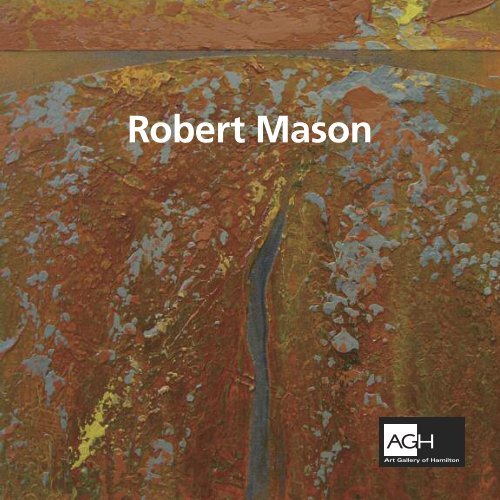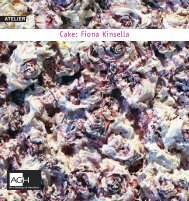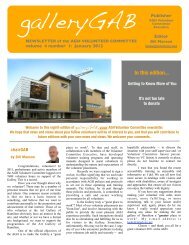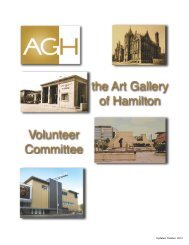Robert Mason - Art Gallery of Hamilton
Robert Mason - Art Gallery of Hamilton
Robert Mason - Art Gallery of Hamilton
You also want an ePaper? Increase the reach of your titles
YUMPU automatically turns print PDFs into web optimized ePapers that Google loves.
<strong>Robert</strong> <strong>Mason</strong>
<strong>Robert</strong> <strong>Mason</strong><br />
Shirley Madill, Guest Curator<br />
Known for his dedication to arts and education in<br />
<strong>Hamilton</strong>, <strong>Robert</strong> <strong>Mason</strong> is remembered and honoured<br />
through this large-scale exhibition that uncovers<br />
significant stages in his art career. Born in 1933 in<br />
Tillsonburg, Ontario, <strong>Robert</strong> studied at the Ontario<br />
College <strong>of</strong> <strong>Art</strong> and received his B.A. in Fine <strong>Art</strong>s from<br />
McMaster University. He taught art classes at Lord<br />
Elgin High School in Burlington and enjoyed a prolific<br />
career that spanned over three decades. <strong>Mason</strong> was<br />
considered <strong>Hamilton</strong>’s greatest ambassador when<br />
it came to supporting local artists, connecting the City<br />
<strong>of</strong> <strong>Hamilton</strong> culturally with the rest <strong>of</strong> the world, and<br />
integrating art within the natural environment.<br />
Expressed through painting, installation, photography<br />
and sculpture, <strong>Mason</strong>’s interests can be contextualized<br />
within larger artistic movements in North America such<br />
as land art and painterly abstraction. Recurring motifs<br />
and themes in <strong>Mason</strong>’s paintings include the landscape<br />
and the natural environment, the planets and the<br />
cosmos, migration and immigration, and the animal<br />
world. Large outdoor and indoor installations, such as<br />
The Floating Gardens, Moving Home, and emigration/<br />
MIGRATION/immigration, evoked his sensitivity and<br />
concern for the natural environment in the face <strong>of</strong><br />
increased industrialization and the compelling desire for<br />
all species to move freely through new territories.<br />
Included in this exhibition are selections from his Self-<br />
Portrait works that explore the artist’s perception <strong>of</strong><br />
himself through monochromatic images <strong>of</strong> clothing; the<br />
Erie Lighthouse series, <strong>of</strong>ten described as “landscape<br />
balanced between the accident <strong>of</strong> nature and the<br />
rational imposition <strong>of</strong> man”; the exquisite and gestural<br />
Romantic Geometry series, paintings intended to<br />
imply wisdom and rational thought; and the final<br />
cosmic paintings produced prior to his death in 2005.<br />
To develop a stronger relation to nature, <strong>Mason</strong> understood<br />
how to generate procreative models for human<br />
culture and civilization. The ebb and flow <strong>of</strong> energies<br />
that are part <strong>of</strong> the process <strong>of</strong> life in our biosphere refer<br />
to the procreative core <strong>of</strong> our desire to transform,<br />
enrich, express, and improve our environment. On a<br />
fundamental level, <strong>Mason</strong> could be considered a landscape<br />
artist; yet his works are driven by a sense that<br />
natural phenomena are at once both transformative<br />
and determined. <strong>Mason</strong>’s work resonates as a potent<br />
reminder that nature still manages to nurture, inspire<br />
and humble us.
emigration/MIGRATION/immigration 1994<br />
mixed media<br />
installed variously at the <strong>Art</strong> <strong>Gallery</strong> <strong>of</strong> <strong>Hamilton</strong>; Cootes Paradise, <strong>Hamilton</strong>; Villa Bruna on Lago di Garda, Abruzzo National Park, Abrezio,<br />
Italy. Caribou heads constructed by students at Sir John A. Macdonald High School, <strong>Hamilton</strong>.<br />
Examining issues <strong>of</strong> social mobility, xenophobia and pride <strong>of</strong> place, in this installation <strong>Mason</strong> focused on Canada’s<br />
first “immigrants” – migratory animals, caribou and birds. The inspiration for the caribou installation came to the<br />
artist during a visit to the Canadian Museum <strong>of</strong> Civilization where he saw a video <strong>of</strong> migrating caribou swimming<br />
across a river. The image planted the seed for themes he was to continue to explore such as the natural environment<br />
and human migration.
MOVING HOME 2001<br />
mixed media installation<br />
installation at Macdonald Stewart <strong>Art</strong> Centre,<br />
Guelph, Ontario<br />
In this seminal work, <strong>Mason</strong> ad -<br />
dresses the notions <strong>of</strong> permanence<br />
and impermanence, stasis and movement<br />
and the migration <strong>of</strong> people,<br />
animals and ideas. The tensions and<br />
resolutions between human culture<br />
and primordial nature that have<br />
informed his work throughout his<br />
career are encap sulated in this work.<br />
Evolving from the earlier installation<br />
emigration/MIGRATION/immigration<br />
that focused on human and animal<br />
migration, this installation focuses on<br />
the compelling desire <strong>of</strong> all species –<br />
plants, animals and humans – not<br />
only to migrate but also to seek a<br />
home.
A Transformative Project<br />
for Negative Spaces 2004<br />
Proposal for public art project for<br />
James Street South, <strong>Hamilton</strong>.<br />
Prototype exhibited at Future Cities<br />
exhibition, 2004, AGH/Jackson Square<br />
A convergence <strong>of</strong> two distinct streams<br />
in <strong>Mason</strong>’s oeuvre appears in this<br />
work: painting and photo-based art.<br />
For the artist, both streams had deep<br />
roots in the tripar tite relationship<br />
between man, nature and architecture.<br />
This proposal began with the assumption<br />
that the urban core <strong>of</strong> <strong>Hamilton</strong> is<br />
not a desirable destination and artists<br />
may provide creative solutions. <strong>Mason</strong><br />
shows that the “in-between” spaces,<br />
their proportions, potential and relationship<br />
to the city whole, are as<br />
important to those who move through<br />
them as the built environment that<br />
surrounds them. These open and<br />
public spaces have an influence on<br />
the emotional and psycho logical wellbeing<br />
<strong>of</strong> the community. The ceiling<br />
<strong>of</strong> this installation is a painting that<br />
attempts to open a dark subterranean<br />
space to the illuminated cosmos.
The Floating Gardens 1993<br />
latex balloons<br />
installed variously in <strong>Hamilton</strong> at the Royal<br />
Botanical Gardens, and in Serbia<br />
The forty circular yellow and pink<br />
intergalactic spheroids were various<br />
colourful latex balloons measuring<br />
six to twelve feet in diameter, and<br />
strategically placed by the artist. In<br />
<strong>Hamilton</strong>, they were placed along the<br />
path <strong>of</strong> the now defunct Desjardins<br />
Canal, a waterway that once connected<br />
Dundas with Burlington Bay.
Third Eye II c. 2004, photographic print, pencil on Mylar, gold leaf, beaver sticks, tackle, <strong>Art</strong> <strong>Gallery</strong> <strong>of</strong> <strong>Hamilton</strong>, Gift <strong>of</strong> the Estate <strong>of</strong> <strong>Robert</strong> <strong>Mason</strong><br />
<strong>Robert</strong> <strong>Mason</strong><br />
April 24 to August 15, 2010<br />
Acknowledgements:<br />
123 King Street West<br />
<strong>Hamilton</strong> ON L8P 4S8<br />
www.artgallery<strong>of</strong>hamilton.com<br />
ISBN: 978-1-897407-07-3<br />
Design & Production: Branka Vidovic, NeoGraphics<br />
Printed in Canada.<br />
© <strong>Art</strong> <strong>Gallery</strong> <strong>of</strong> <strong>Hamilton</strong>. All rights reserved.<br />
The <strong>Art</strong> <strong>Gallery</strong> <strong>of</strong> <strong>Hamilton</strong> is pleased to present this survey <strong>of</strong> the influential <strong>Hamilton</strong><br />
artist <strong>Robert</strong> <strong>Mason</strong>. We are grateful to Shirley Madill as Guest Curator. On behalf <strong>of</strong><br />
Shirley and the AGH, we would like to thank Lisa Audette, the Estate <strong>of</strong> <strong>Robert</strong> <strong>Mason</strong>,<br />
the lenders to the exhibition, Sara Knelman and Sheila Greenspan. Thank you to<br />
Branka Vidovic <strong>of</strong> NeoGraphics and the AGH staff for their hard work. The AGH also<br />
thanks the City <strong>of</strong> <strong>Hamilton</strong>, the Ontario <strong>Art</strong>s Council and the Canada Council for the<br />
<strong>Art</strong>s, and additionally the Members and Friends <strong>of</strong> the <strong>Gallery</strong>.
















